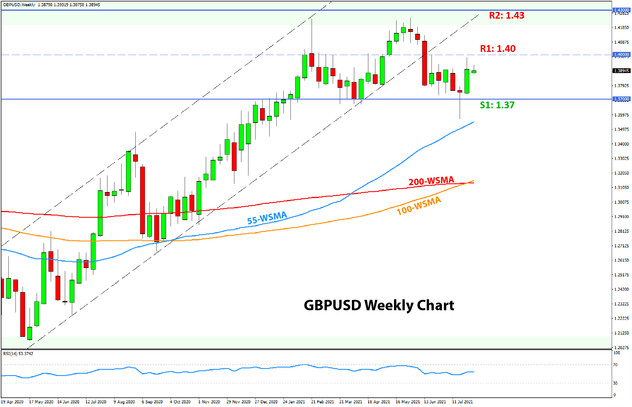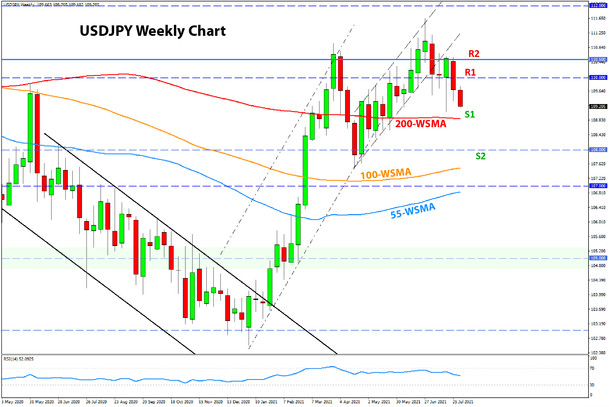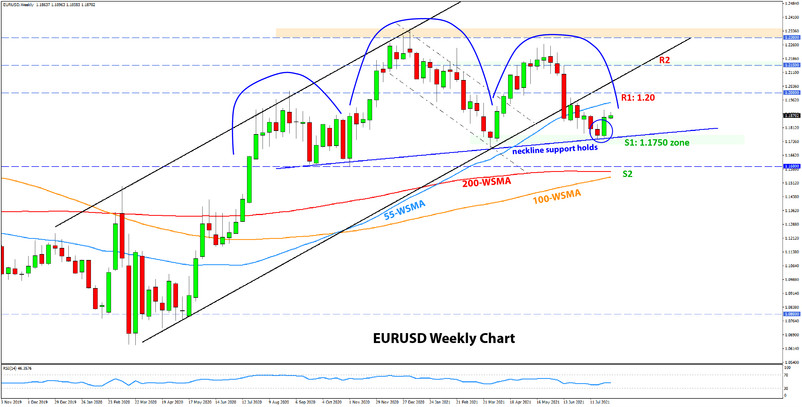US Dollar Fundamental Outlook: Nonfarm Payrolls Is a Big Test for the USD Bull Trend
The Fed meeting last Wednesday was a slight disappointment for the biggest USD bulls as Chairman Powell chose to focus his speech on the need for substantial further progress in employment rather than surging inflation as a condition for tapering QE purchases. And it makes sense as a tactical move from Powell to cool off markets from running ahead of themselves, even if the Fed is still likely going to start tapering in the coming months. This is why the dollar, sooner or later, should find its upward trajectory again (the Fed is ahead in the tapering race), though for this week Powell s disappointment may linger and keep USD pressured. However, with Friday’s key Nonfarm Payrolls report starring us in the face, it’s highly unlikely that the established ranges will be broken before Friday.
In line with Powell’s press conference, the NFP seems like the real test for the dollar and Fx trends this week. The Fed wants to see strong job gains before talking more seriously about tapering or any form of tightening policy. Consensus forecasts by economists expect the NFP to print around 900K jobs. Anything substantially above that (think 1 million plus) would likely jumpstart the dollar rally again. The unemployment rate is also an important component to watch, with forecasts projecting a drop to 5.7% from 5.9% the previous month.
On the other hand, weakness in the jobs reports could refuel the USD slide as it will likely discourage the Fed from swiftly progressing with tapering plans. Though unlikely, such an outcome could potentially do some more serious USD damage broadly, especially if jobs disappoint big time. Other important reports on the US calendar this week are the ADP employment change, and the ISM manufacturing and services PMIs.
Euro Fundamental Outlook: EUR Unlikely to Deviate from the Established Course
The EUR traded generally firmly last week, though the lack of a clear domestic directional factor keeps the currency in its largely neutral phase, and EUR pairs continue to be impacted more by global factors and specific developments with other currencies. The solid economic data prints last week also helped to support the euro, though without any longer-term implications.
This week’s light EUR calendar consisting of mostly (non-market moving) 2nd tier reports means that this narrative will likely continue. Perhaps only worth watching will be the retail sales, and German factory orders and industrial production numbers, though they are too unlikely to have any impact on EUR exchange rates this week. The Covid pandemic in Europe is relatively stable for now, though the rise of the delta variant is a theme that traders are closely watching as an unexpected negative shock (such as new lockdowns) could negatively impact the currency.
For the long-term horizon, the recent dovish change at the ECB (with the new symmetrical 2% inflation target) is likely to act as a slight bearish factor in the months ahead, that will add additional pressure on the EUR in bad times and likely act as a headwind during good times.
EURUSD Technical Analysis:
The solid bounce on the last weekly candle now shifts the technicals slightly more bullish here. As we said in previous weeks, the neckline support wasn’t going to break easily, and with that tall green candle showing up on the chart now, the case is even stronger for EURUSD to stage a rally and test the 1.20 resistance area.
The 1.20 remains the strong and most important resistance at this juncture. The next resistance higher is located around the 1.21 level at that former channel support line (broken in June).
To the downside, support remains pinned at the 1.1750 area, which has now been even more solidified after it held off the bearish attempts.
British Pound Fundamental Outlook: Expect Volatility Around Thursday BOE Meeting on Thursday
Sterling extended the gains from the rebound that started on July 20 and was the top-performing currency in the past week. Hawkish comments from some BOE MPC members recently fueled expectations for rate hikes and helped to lift GBP. The improvement of the Covid situation in the UK following the full reopening two weeks ago also lent a hand to GBP as new infections are steadily dropping since then.
Overall, it appears GBP has found its feet again, and it is no wonder that GBPUSD is trading close to 1.40 and EURGBP is pressing on the lows near 0.85. Many expect the Bank of England to keep their relatively hawkish stance at the meeting this Thursday, but particularly because of that, there may be scope for disappointment. Namely, the BOE could still use the surge of the delta variant as a reason for patience at the moment and refrain from laying out any plans for tightening policy. This could disappoint GBP bulls and trigger a sell-off in the currency.
On the other hand, if the BOE communication is focused on the positives (such as the containment of the delta variant) and even reveals detailed plans for when tapering and rate hikes will come, GBP can extend the rally much higher. In either case, expect volatility around the BOE event, after which we should be able to assess the GBP outlook with greater clarity.
GBPUSD Technical Analysis:
Similarly to EURUSD, cable also recorded a bullish engulfing candle pattern on the weekly chart. However, the technicals here are not as clear as on EURUSD in terms of having specific support/resistance levels and orderly price action on the charts.
1.40 is an important psychological level, and as can be seen from the weekly chart below, the price reacted with it several times in the past 5-6 months. So, it’s the nearest important resistance to current levels, and the price already reacted to it, with GBPUSD closing the past week some 90 pips off the highs.
Further higher, the highs around 1.43 are the next resistance which also serves as the top of this rangy formation in GBPUSD between 1.37 and 1.43.
Support is toward the bottom of that range, around 1.37.

Japanese Yen Fundamental Outlook: JPY Drifting Along Without Much Directional Clarity
The Japanese yen was one of the firmer currencies last week and mainly strengthened versus the dollar, as most other currencies. JPY was weaker against GBP, CHF, EUR, and CAD, but it was stronger versus AUD and NZD. The takeaway from such dynamics is a mixed one since there were no clear outperformers or underperformers of the “risk-on” or “safe-haven” packs. Perhaps this is another testament to the lack of clear directional clarity in the Fx market at the moment, especially when it comes to currencies like JPY and CHF.
Nonetheless, the yen remains closely linked with risk sentiment and is already strengthening today as equity markets are on a decline again. But we can’t make too much of the decline in stocks, because as we know, dip buyers are likely to come in again (as is typical) and reverse the sell-off once again. So, the yen may continue to trade on technical factors more than on specific fundamentals in the current environment of low volatility in equities and US Treasury bond yields.
USDJPY Technical Analysis:
USDJPY is struggling to maintain lower levels below 110.00 here, even though the technicals turned quite bearish in recent weeks. The rejections of lower levels near the 109.00 level in the past two weeks suggests that the bearish momentum has waned. The bulls will face resistance at the psychological 110.00 level, but perhaps the more important one in the current context will be at those highs around 110.50, which they need to conquer as a first sign that bulls are taking back control.
To the downside, the 109.00 zone is now established as the key support based on the rejections and the nearby 200-week moving average (red line). A break below this area should open the door for further losses in USDJPY toward the next support, located at the 108.00 zone.






